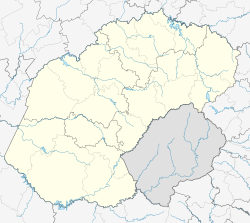Villiers | |
|---|---|
| Coordinates: 27°02′S28°36′E / 27.033°S 28.600°E | |
| Country | South Africa |
| Province | Free State |
| District | Fezile Dabi |
| Municipality | Mafube |
| Established | 1891 [1] |
| Area | |
• Total | 9.3 km2 (3.6 sq mi) |
| Population (2011) [2] | |
• Total | 17,315 |
| • Density | 1,900/km2 (4,800/sq mi) |
| Racial makeup (2011) | |
| • Black African | 94.0% |
| • Coloured | 0.3% |
| • Indian/Asian | 0.3% |
| • White | 5.1% |
| • Other | 0.2% |
| First languages (2011) | |
| • Sotho | 66.7% |
| • Zulu | 19.6% |
| • Afrikaans | 6.2% |
| • Xhosa | 2.2% |
| • Other | 5.4% |
| Time zone | UTC+2 (SAST) |
| Postal code (street) | 9840 |
| PO box | 9840 |
| Area code | 058 |
Villiers is a small town situated on the banks of the Vaal River next to the N3 highway in the Free State province of South Africa, on the border with Mpumalanga province. It is part of the Mafube Local Municipality. It was founded in 1882 on the two farms Pearson Valley and Grootdraai owned by Lourens de Villiers.


